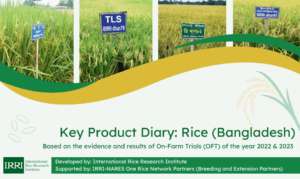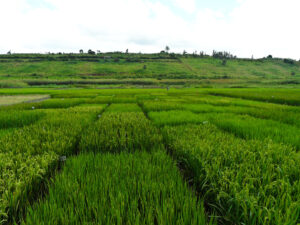by Catherine Propper, Jodi Sedlock, Richard Smedley, et al.
In Southeast Asia, as mechanization increases, there is a need to evaluate the impact of how related changes in farming practices affect biodiversity. Furthermore, because of the large land area grown for rice, and the disproportionate share of agro-chemical inputs used to produce it in Southeast Asia, improving the environmental sustainability of rice landscapes would significantly benefit biological diversity conservation in the region.
Rice is the dominant food staple in Asia. In Asia, there are 52 million ha of lowland irrigated rice that provides food security to smallholder farmers while also having the potential to preserve wetland habitat for wildlife. Globally, all wetland habitats are at grave risk, and as a result, there are great concerns about the rates of loss of biological diversity.
A report from the 13th Meeting of the Conference of the Contracting Parties to the Ramsar Convention on Wetlands (COP13) highlighted that 35% of wetlands have been lost since 1970. A follow-up report in 2021 highlighted the conversion of wetlands to agricultural land use as an important process, with greater than 50% of wetlands at a global level being negatively impacted by agriculture either directly through land use conversion or indirectly through runoff of pesticides and inflow of plastics.
Rice agricultural systems provide important human-modified wetlands for wildlife, including undomesticated vertebrates. In an ecosystem service context, flooded rice wetland environments potentially provide important “supporting services” for wildlife through their extensive water networks. The border habits of agricultural lands in Europe are well documented as keys to the preservation and conservation of wildlife.
For example, the growth of native herbs, grasses, and wildflowers along these margins provides refuge for important pollinators and bird species. In Asian lowland rice agroecosystems, there has been a relative paucity of studies investigating the benefits of heterogeneous agricultural landscapes on biodiversity. One exception has been studies on the benefits of ecologically engineering lowland rice margins by growing wildflowers and cultivating additional vegetables along the bunds and the wider margins of rice fields.
Ecologically engineering rice field margins have reportedly positive spill-over benefits to farmers through increased bird activity that may lead to increased pest control in rice fields.
In this review, we will focus primarily on vertebrate faunal biodiversity. Our aim is to set our sights beyond Sustainable Development Goal (SDG) 2, which focuses on ending hunger and achieving food security via the promotion of sustainable agriculture, ideas that are also synonymous with the One Health initiative.
Often, agricultural scientists are motivated to achieve food security but pay insufficient attention to the need to have a healthy and resilient agroecosystem that supports biodiversity. Given the documented loss in global biodiversity, especially in tropical zones, resulting from deforestation for agriculture and mining, we need to set our sights on how best to integrate SDG 2 and SDG 15 in this region of intensification of rice agriculture.
These goals emphasize the need to promote sustainable use of terrestrial ecosystems and halt biodiversity loss. The tropics cover 40% of the world’s land mass and are home to 91% of terrestrial birds and > 75% of amphibians and terrestrial mammals. In addition, ecologists who address SDG 15 in terrestrial agricultural systems need to balance their efforts so that SDG 2 is not compromised. This issue has also been clearly captured in target 10 of the Convention on Biological Diversity 2030 framework.
Conversion of land to agricultural use has been identified as a significant driver of biodiversity loss. Milled rice demand will increase by an additional 100 million tons year−1 by 2050, and most of this extra production will occur in Asia; therefore, failure to act on finding sustainable growth practices will lead to significant further biodiversity loss. However, there is cause for optimism, as a growing volume of research has indicated that, if managed effectively, agroecosystems can be more resilient and generate positive effects on biodiversity.
Given the relative paucity of published studies on vertebrate faunal biodiversity in rice agricultural lands of developing countries, particularly in biodiversity hotspots such as Southeast Asia (Myers, 1988), this review will report on studies in lowland rice agroecosystems over the past decades on vertebrate faunal ecology and biodiversity in this region. A key focus is identifying the likely positive ecosystem services provided by vertebrate fauna in intensive lowland rice production in Southeast Asia.
Our review highlights the urgent need to rethink how rice landscapes are managed in Southeast Asia. We highlight that they are often overlooked biodiversity hubs that bristle with life. The unique semi-aquatic nature of rice farming systems means that rice landscapes offer habitats to numerous native species, some of which are threatened or endangered.
However, research has also highlighted that today’s prevalent rice farming practices across Asia often have one of the highest ecological footprints among agricultural commodities in the region, exacerbating the biodiversity crisis. In other areas of the world, rice agricultural practices have also led to a demonstrable loss of diversity .
In Southeast Asia, as mechanization increases, there is a need to evaluate the impact of how related changes in farming practices affect biodiversity. Furthermore, because of the large land area grown for rice, and the disproportionate share of agro-chemical inputs used to produce it in Southeast Asia, improving the environmental sustainability of rice landscapes would significantly benefit biological diversity conservation in the region.
For example, we suggest that significant resources should be devoted to establishing routine monitoring for concentrations of pesticides in rice surface water, sediment, and local wildlife and to identify their biological effects in wildlife communities. In countries where there may be limited resources for monitoring chemical applications, using tools that are available to understand the potential impacts of exposure for wildlife, such as the United States Environmental Protection Agency’s publicly accessible toxicity database, the Ecotoxicology Knowledgebase, can provide some predictive capacity for understanding the risk to the local fauna from chemical exposures. This approach would support delivering jointly upon the SDG 2 and SDG 15 2030 targets.
Acknowledgments
The study was supported by the Swiss Agency for Development and Cooperation through the CORIGAP project. Further support was provided by Lawrence University and by the United States National Institutes of Health. Research on the presence of birds and their interaction within lowland irrigated rice fields was conducted as part of a Global Rice Science Partnership-funded PhD study with IRRI and the University of Reading, UK.
Read the study
Propper C, Sedlock j, Smedley et al. (2024) Balancing food security, vertebrate biodiversity, and healthy rice agroecosystems in Southeast Asia. Crop and Environment, Volume 3, Issue 1.






